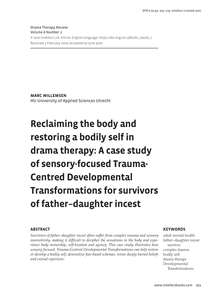In this project we take a look at the laws and regulations surrounding data collection using sensors in assistive technology and the literature on concerns of people about this technology. We also look into the Smart Teddy device and how it operates. An analysis required by the General Data Protection Regulation (GDPR) [5] will reveal the risks in terms of privacy and security in this project and how to mitigate them. https://nl.linkedin.com/in/haniers
MULTIFILE

Survivors of father–daughter incest often suffer from complex trauma and sensory insensitivity, making it difficult to decipher the sensations in the body and experience body ownership, self-location and agency. This case study illustrates how sensory focused, Trauma-Centred Developmental Transformations can help restore or develop a bodily self, desensitize fear-based schemas, revise deeply buried beliefs and extend repertoire.
DOCUMENT

The creation of artifacts is one of the factors that make us human. Artifacts contribute to our continual adaptation to the world by permitting better knowledge and control of it. The focus of this chapter is on the role of one specific kind of artifact: sensors. In contrast to our immediate perception of the world from our senses, sensors provide large amount of reliable measurements of the physical world that enhance human cognitive capacities in overcoming our perceptual limitations. However, “raw” sensor data require interpretation that relies on different types of expertise and knowledge to provide relevant meaning for human (adaptive) purposes. We suggest that a cognitive approach to understanding the differences between the different types of knowledge provided by current sensors as artifacts and the human senses is of interest. This approach questions the conception of human cognition as an analytic system of processing information from the world rather than as one which interprets and gives meanings to the world. We posit that understanding the differences between human and artificial sensors can shape a new era of technological advancement that is uniquely collaborative insofar as it would rely on the partnership of scientists working in the Humanities and in the Natural Sciences. In this article we provide some data from cognitive research that outline the beginnings of a pluridisciplinary endeavor to conceive sensors which integrate performances of artifacts and the diversity and richness of human cognition, with the goal of transforming so-called “intelligent” devices into cognitive sensors.
LINK
In de ontwikkeling van voedingsmiddelen draait alles om smaak. Eten moeten vooral lekker zijn, toch? Om smaak en andere producteigenschappen in kaart te brengen wordt sensorisch onderzoek (SO) uitgevoerd. In de praktijk gebeurt dit vaak onder suboptimale omstandigheden vanwege bijvoorbeeld onvoldoende beschikbaarheid van panelleden en een gebrek aan tijd. Belangrijke beslissingen worden vervolgens gebaseerd op onbetrouwbare, invalide resultaten. Er is daarom een behoefte naar snelle, betrouwbare en valide methodieken. Daarbij geldt dat voedselkeuze een complex proces dat verder gaat dat het analytisch beoordelen van producteigenschappen. Zo kan de context van consumptie van invloed zijn op de perceptie van smaak. In het sensorisch onderzoeksveld is hier steeds meer aandacht voor. Hiermee beweegt SO zich richting consumentenonderzoek (CO). De overlap en wederzijdse beïnvloeding van elementen uit SO en CO zijn relevant tijdens verschillende fases van het productontwikkelingsproces. In dit postdoconderzoek zal Vera van Stokkom een snelle en flexibele onderzoeksmethode ontwikkelen en valideren. Elementen van SO en CO zullen geïntegreerd worden in een methodiek onder de werktitel Rapid Sensory & Consumer Modules Tool (RSCM-tool). De methodiek zal worden gericht op de productcategorie groenten. Groenten passen bij uitstek in een gezond en duurzaam voedingspatroon. Ook zal worden onderzocht of de RSCM-tool kan worden ingezet bij ouderen, omdat bij ouderen achteruitgang in sensorische perceptie plaatsvindt. Met dit postdoconderzoek wordt kennis en ervaring opgedaan over de toepassing van een nieuwe sensorische onderzoeksmethodiek (RSCM) die uiterst relevant is voor onderzoek met, en onderwijs op het gebied van voeding. Dit postdoconderzoek valt onder het Research and Innovation Centre Agri, Food & Life Sciences van Hogeschool Inholland. Naast een verbreding en verdieping op de onderzoekslijn Gezondheid in de Metropool en het domeinoverstijgende onderzoeksprogramma Food for Happy Ageing, zal dit onderzoek bijdragen aan duurzame curriculuminnovatie binnen de opleiding Food Commerce and Technology en de profilering van Hogeschool Inholland als kennispartner.
Inside Out is an innovative research project that translates cutting-edge microbiome science into immersive, multisensory experiences aimed at long-term behavioral and mental health transformation. Combining extended reality (XR), speculative gastronomy, and narrative therapy, the project enables participants to explore their inner microbiome landscape through taste, smell, touch, and interactive storytelling. This pioneering methodology connects gut-brain science with emotional and sensory engagement. Participants experience their bodies from the inside out, cultivating a visceral understanding of the symbiotic microbial worlds within us. The project includes AI-generated "drinkable memories," microbiome-inspired food designs, haptic-olfactory VR environments, and robotic interactions that choreograph the body as terrain. Developed in collaboration with designers from Polymorf, producer Studio Biarritz, psychiatrist-researcher Anja Lok, and microbiome scientists from Amsterdam UMC and the Amsterdam Microbiome Expertise Center, Inside Out bridges scientific rigor with artistic expression. The project seeks to: • Increase embodied understanding of the microbiome’s role in health and well-being • Shift public perception from hygiene-based fear to ecological thinking • Inspire behavioral change related to food, gut health, and mental resilience The outcomes are designed to reach a large audience and implementation in science museums, art-science festivals, and educational programs, with a view toward future clinical applications in preventive healthcare and mental well-being. By making the invisible microbiome tangible, Inside Out aims not only to inform, but to transform—redefining how we relate to the ecosystems within us.